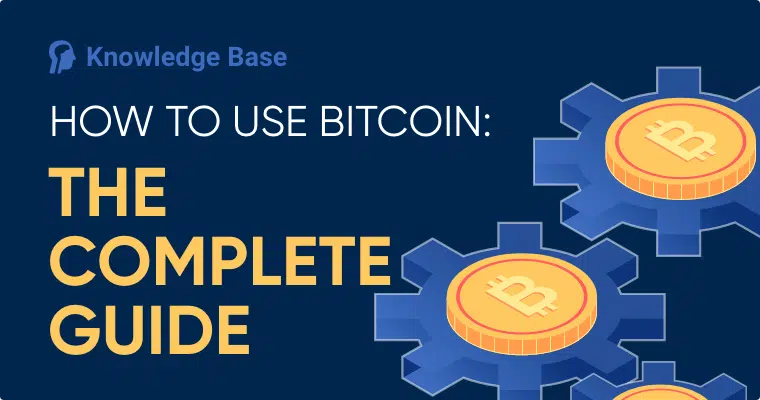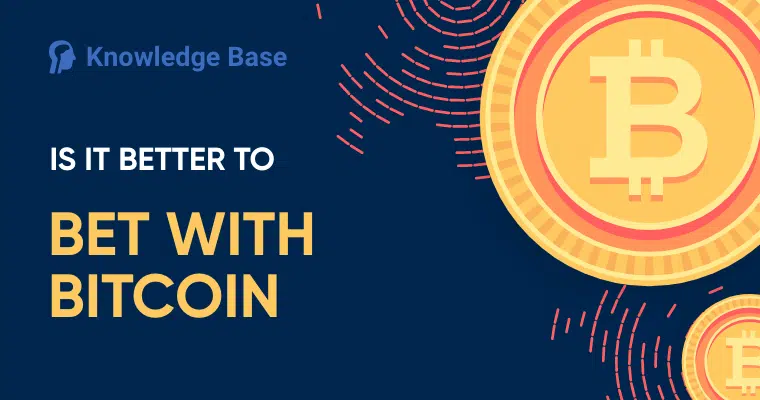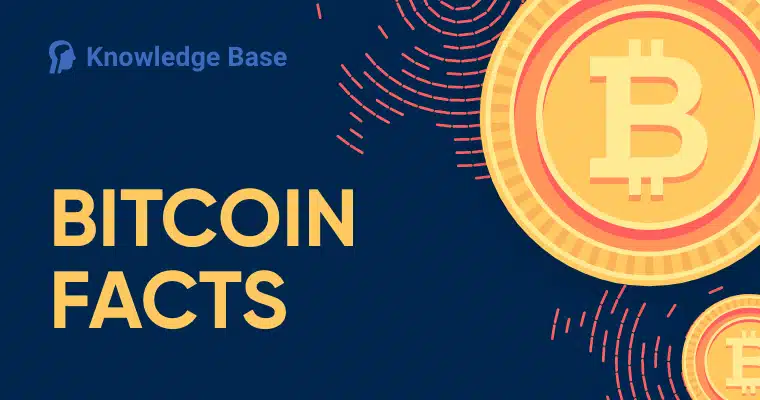How To Use Bitcoin: The Complete Guide
Contrary to what people say, Bitcoin was not the world’s first cryptocurrency.
In 1982, a UC-Berkeley doctoral candidate named David Chaum published a dissertation that included the specification and source code for a digital currency based on a cryptographically secured distributed database. Chaum founded a company called DigiCash in 1989 and introduced a blockchain-based digital currency called eCash in 1995. Ahead of its time, DigiCash filed for bankruptcy in 1998.
A decade later, Satoshi Nakamoto’s famous whitepaper on cryptocurrency appeared in an online cryptography journal, and in 2009 Nakamoto launched Bitcoin.
Cryptocurrency has attracted a lot of attention from investors, journalists, and computer programmers since then. What’s lacking is a plain English guide to how to use Bitcoin in the real world.
That’s where we come in.
Why Bitcoin?
People get into the Bitcoin world for three main reasons.
Some purchase Bitcoins as a commodity, buying them when the price is low and selling them when the price rises. About 40% of the world’s Bitcoins are owned by the top 1,000 big-money investors. These speculators don’t buy and sell things with Bitcoins; they add the e-coins to their portfolios in hopes they will appreciate in value.
Others are motivated to learn how to use Bitcoin because the e-money is not burdened by the regulations and oversight that complicated transactions made with government-issued currencies. Most ransomware hackers request their payoff in Bitcoin, for instance, because the coins can’t be tracked to them. Offshore casinos encourage American gamblers to use Bitcoins because crypto transactions may not be subject to the same regulations as money transfers.
Finally, there are everyday consumers who appreciate Bitcoin because transfers are fast, free, and anonymous. They’re not investors and they’re not evading the law; they just want to use this digital-age currency to escape the fees and regulations of the banking industry.
How To Set Up a Bitcoin Account
Before you set up a Bitcoin account, there are a few things you should know so you can keep your money secure and avoid common mistakes.
The price of Bitcoin is highly volatile, which means it can unpredictably increase and decrease a great deal in a short time compared to dollars or euros or other currencies. It is a new economy, so investing your savings in Bitcoin is a risky move. You could find the value of your retirement fund slashed in half overnight. If you receive payments in Bitcoin, consider converting at least a portion of the money into your local currency. Understanding the risks is an important goal of this Bitcoin tutorial.
Bitcoin transactions are irreversible, and can only be refunded by the person who received the funds. This means if you decide to get started with Bitcoin, you should do it with people and organizations that you know and trust.
Although Bitcoin has many benefits – user anonymity and avoiding expensive bank fees, for example – it is still an experimental currency that is in active development. If you decide to get into Bitcoin trading, you can expect higher fees, slower confirmations, and other complex issues. You should be prepared for problems, so it is wise that you consult a technical expert before making any major investments.
How To Buy and Use Bitcoin
To make transactions on the Bitcoin network, you must create a Bitcoin wallet.
Bitcoin wallets are software programs that handle all of your transactions with Bitcoins and the underlying blockchain database. Your wallet can accept transactions and transfers encoded with your public cryptographic key, for instance, and it can use your private key to access the blockchain and determine your balance.
You can think of your public key and private key as passwords that allow your wallet to encode and decode transactions.
You don’t really have to know how to use a Bitcoin private key in any technical depth, because your wallet handles that for you. But it’s good to know.
When you are to receive Bitcoins, your wallet generates a private key and a public key that are good for just one transaction. The public key works as the address for the Bitcoins that the other party is sending you. The private key allows your wallet program to access the funds. The sender is anonymous. There is no “from” address in Bitcoin transfers.
Your wallet can show you all of your public keys and the funds associated with them. It is like a bank statement for your Bitcoin account.
You don’t have to understand how public and private keys work to learn how to use Bitcoin. But if you’re interested, you should know that public and private keys are strings of 35 numbers and letters. Some keys appear shorter because leading zeros are removed. The keys are used to store encrypted details about the transaction in the blockchain open ledger that underlies Bitcoin.
Because your wallet program has full access to your Bitcoin funds, you must secure it with a strong password. If you lose access to your wallet, you also lose your cryptobucks.
Bitcoin wallets are high-value targets for hackers, so wallet security is a top priority. When you learn how to invest in Bitcoin, you should start by learning how to secure your wallet.
Wallets come in four flavors: desktop, mobile, web, and hardware.
Desktop Wallets
With a desktop Bitcoin wallet, you have complete control of your account with no third-party involvement. You can store your data on the hard drive of your PC or laptop. Then you can send and receive coins from anywhere as long as you remember your details. There are several desktop wallets available. We recommend Exodus for beginners. For extra security, check out Electrum and Bitpay.
Mobile Wallets
You can also set up a Bitcoin wallet on mobile devices. A wallet on your smartphone is handy for making “touch to pay” and Near Field Communication purchases. It’s very convenient if you shop at retailers that accept Bitcoins.
All you’ve got to do is install a mobile wallet on your iOS or Android device. Most desktop wallets include mobile apps. For a mobile-first approach, check out Hive and Mycelium.
Be sure to download only from authorized app stores, and take a moment to check out reviews. Hackers are creating malware that masquerades as wallets in hopes of getting access to your Bitcoin wallet address – and all your funds.
Web Wallets
Web wallets run in your browser. Your keys are stored in the cloud, accessed using a password of your choosing.
With a web wallet, your private keys aren’t stored on your hard drive or in your smartphone. You’ve uploaded it to the cloud. The best web wallets encrypt all of your data and require strong passwords or two-factor authentication. Treat your web wallet password with the same respect you afford your online bank account – because that’s really what it is. As you learn how to set up and use Bitcoin, you will gain an appreciation of the amount of trust you must have in your web wallet provider.
Hardware Wallets
A hardware wallet provides the ultimate in security. With a hardware wallet, your information is encrypted and stored on a physical device like a thumb drive that plugs into your computer’s USB port.
A hardware wallet can have lots of built-in security measures, and no one can access your Bitcoins without physically possessing the device and the password. Hardware wallets are secure against most virus attacks, too. Among the best are the Trezor, Ledger Nano, Coinkite Coldcard, and ShiftCrypto BitBox. If you want to start paying with Bitcoin, consider a hardware wallet.
Buying and Selling Bitcoins
There are three main ways to acquire cryptocurrency.
- You can do what most people do: Use everyday money to buy Bitcoins, either at a web-based exchange site or at a Bitcoin ATM (BTM).
- You can invest in the currency, being awarded coins as part of an initial count offering, or ICO, which is much like the initial public offering of a company that first makes shares available on a public stock exchange. This is only for new currencies – there will be no public offerings for Bitcoins.
- Finally, you can use your computer to verify transactions on the blockchain, a process called “mining,” and receive small Bitcoin payments in return.
Bitcoin Exchanges
Beginners who need to know how to buy Bitcoin are best served by visiting exchanges, which are websites where you can use a credit card, debit card, PayPal account, or other methods to purchase Bitcoins and other cryptocurrencies. Some exchanges serve as web wallets, but ordinarily, you will transfer the funds to your Bitcoin wallet once the transaction is complete. Every exchange works differently, so you need to follow the directions closely.
Exchanges have access to a central cache of Bitcoin funds that you can buy. Some exchanges also let you participate in peer-to-peer transactions, in which you purchase crypto funds from another user. You should learn how to use Bitcoin anonymously if P2P trading is in your future.
Coinbase, Coinmama, and Gemini are some of the most popular exchanges, but you might want to do a little research before choosing one. Many Bitcoin exchanges offer great fast solutions, but it’s important to read reviews from experts and customers before choosing where to make your purchase. You’re entrusting real money to strangers, after all.
Some exchanges record transactions along with identifiable personal information that can be provided to banks, tax collectors, and government authorities. Other exchanges advertise complete privacy. Among the best anonymous exchanges are Binance, TradeOgre, and ShapeShift.
How To Use a Bitcoin ATM
Bitcoin ATMs are physical Bitcoin exchanges that look like regular ATMs. You can use a credit or debit card to purchase Bitcoin funds there and transfer them to your wallet. You can also withdraw dollars or euros, with the balance deducted from your Bitcoin funds.
These ATMs have become increasingly popular over the years. A website called Coin ATM Radar lists more than 14,000 in 71 countries, and it can help you find one that’s near you.
Bitcoin ATMs let you buy and sell Bitcoins anonymously, which makes them appealing to some Bitcoin users. This privacy comes at a price, however: Bitcoin ATMs generally charge a fee of 7% to 10% for each transaction.
How To Use a Bitcoin Miner
Bitcoin mining brings new Bitcoins into the world. It is performed by volunteers in return for verifying blockchain transactions.
Verifying a 1 MB block of transactions takes only a moment. A second step keeps the volunteers motivated. Mining software on the computers that verified the block uses special algorithms to generate a 64-digit number that is equal to or lower than a particular target. The user that generates a conforming hash first receives a reward, which currently stands at 6.25 newly minted Bitcoins. In late January 2021, those Bitcoins are worth more than $200,000.
Clearly, it makes sense to learn how to use a Bitcoin miner.
In the early days of Bitcoin, users ran mining software on ordinary PCs. Later, they adapted the algorithms to run on high-performance graphics processors. Now, most serious mining is done on custom-built mining computers powered with application-specific integrated circuits, or ASICs. Groups of users team up to perform the hashing calculations simultaneously. If any member of the pool wins the reward, everyone in the pool shares it.
Buying Coffee With Bitcoin
Although many people use Bitcoin as an investment, a growing number of retailers and online businesses accept Bitcoin as a form of payment. Anonymity and low fees mean it’s beneficial to learn how to use Bitcoin to buy things.
Bitcoin purchases are anonymous, which means your purchases can’t be associated with your identity. Like cash purchases, Bitcoin purchases cannot easily be tracked. The anonymous Bitcoin address that is generated for each purchase changes with every transaction. This doesn’t mean that Bitcoin transactions are entirely untraceable, but it’s still more anonymous than just about any other form of payment.
Here are some of the things you can pay for with Bitcoins.
Travel
Travel websites have eagerly joined the cryptocurrency revolution, and you can use your Bitcoin wallet to pay for everything from flights and hotels to rental cars and cruises. Bitcoin is an international currency, which makes it great for frequent travelers. Wondering how to use your Bitcoin wallet in a fun way? A vacation or business trip might be just the ticket.
Bitcoin Gambling
Bitcoins are great for gamblers where local laws make real-money casino gambling and sports betting illegal. Because it isn’t a legal currency, Bitcoin can be used to fund casino accounts and collect winnings without violating laws that prohibit financial transactions associated with gambling.
Operators of online casinos outside the United States are especially eager to get their members to use Bitcoin and other cryptocurrencies.
No matter what kind of gambling you like, you can find a Bitcoin-compatible destination that’s enticing enough to make you learn how to use a Bitcoin machine. Casino sites offer slots, table games, live dealer games, and video poker. Sportsbooks let you bet on sporting events. And online poker rooms let you test your skill against players all over the world.
Online Shopping
Consumers love the convenience of online shopping, and online retailers are quickly adopting Bitcoin and other cryptocurrencies as a preferred payment method. The American clothing retailer called Overstock is one of the first well-known retailers to welcome Bitcoin purchases. Home Depot, iTunes, Expedia, and the Microsoft Xbox Store accept crypto funds too.
If you are wondering how to use Bitcoin for online shopping and whether it’s safe, the short answer is – yes, go ahead.
Bitcoin Versus Bitcoin Cash
As Bitcoin grew more popular, transaction speed started to suffer. Transaction processing time grew longer and longer, leading to delays that offset one of the main benefits of cryptocurrencies – instant transactions.
Technology experts blamed Bitcoin’s 1 MB block size. If blocks were bigger, more transactions could be verified at once.
That line of reasoning led to the creation of Bitcoin Cash.
Want to learn how to use Bitcoin cash? You already know the basics from our discussion of Bitcoin. Let’s dive in.
Bitcoin Cash is a separate currency that runs on its own blockchain.
The Bitcoin Cash blockchain is just like Satoshi Nakamoto’s original, except that blocks hold 8 MB to 32 MB of data instead of just 1 MB. This means many more transactions are verified at once.
Bitcoin Cash coins are worth substantially less than Bitcoins. You can swap one currency for the other at an online Exchange.
If you have a Bitcoin wallet, you already know how to use a Bitcoin Cash app.
You can use Bitcoin cash at more than 5,000 brick-and-mortar businesses worldwide, plus online retail shops and restaurants. Bitcoin Cash also offers a unique catalog of travel options and point-of-sale solutions for businesses.
Conclusion
That’s the big picture, plus just enough technical details to help you understand what cryptocurrencies and blockchains are. We got all the way to the end of the article without a single line of Java or Python code. Relieved?
Now you know where and how to use Bitcoin. You’re ready to set up a wallet, buy some coins at an exchange, and patronize an online business or two. Although a lot is happening under the surface, you’ll see that sending and receiving money with your Bitcoin wallet is no more complicated than using PayPal or your bank’s smartphone app.
Bitcoin enthusiasts are idealistic about freeing financial transactions from government oversight and the regulations and fees associated with the banks that handle most transactions today. That crypto nirvana may never come to pass, but if it does, we hope this article has helped prepare you for it.






